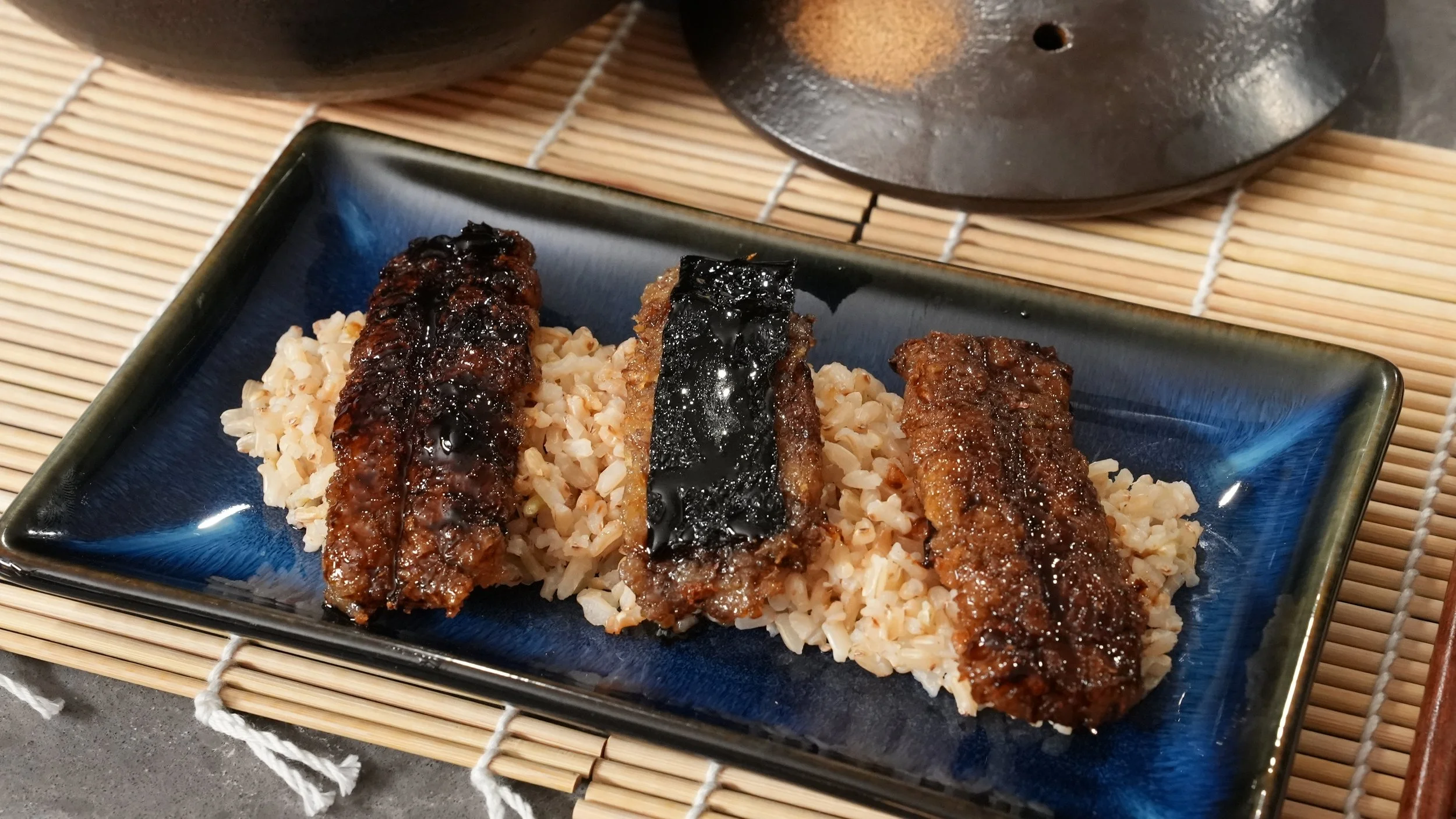Sweet Potato Mock Eel Kabayaki
Fried sweet potato paste on top of roasted seaweed with a soy glaze and brown rice
City/Region: Japan
Time Period: December 1942
Contrary to the government’s promises, the availability of food declined in Japan as World War 2 went on. Journal entries from 1945 highlight just how bad things had gotten. People were unable to get ahold of staples like rice, soy sauce, miso, and fuel for cooking fires, and many were scavenging for anything to eat.
This recipe comes from a few years earlier when things were tight, but not quite so dire. While it doesn’t exactly taste like grilled eel, it is quite good. There’s a nice crispiness to it (more so before the glazing and grilling), and the glaze is delicious. It kind of reminds me of the breading that you might get on some katsu.
“Kabayaki of Sweet Potato
Ingredients for 5 servings
100 monme sweet potatoes
2 tablespoons wheat flour
1 teaspoon salt
15 sheets of roasted seaweed
Grate the sweet potatoes with a grater and grind. Mix in the flour and salt. Spread the mixture onto the roasted nori to a thickness of about 1/2 cm. Fry them in oil until golden brown. Separately, make a soy sauce glaze in the ratio of 3 parts soy sauce to 2 parts sugar. Dip in the glaze and grill them. Repeat this twice, brushing with sauce each time. On the third, use only the sauce without grilling. ”
Ingredients:
Mock Eel Kabayaki
13 oz (375 g) Japanese sweet potatoes
2 tablespoons (15 g) flour
1 teaspoon salt
Several sheets of nori (roasted seaweed)
Vegetable oil, for frying
Cooked brown rice*, for serving
Terishoyu (Soy Sauce Glaze)
- 6 tablespoons (85 g) soy sauce
- 4 tablespoons (50 g) sugar
*Some people were still able to get ahold of brown rice in December 1942, so I’m using it here.
Instructions:
- To make the mock eel kabayaki: Scrub the sweet potatoes well. Grate the sweet potatoes on the small holes of a grater, then grind it in a mortar into a paste. It probably won’t get completely smooth or paste-like, but do the best you can. Depending on the size of your mortar, you may need to do it in a few batches.
- Transfer the sweet potato paste into a bowl and mix in the flour and salt until it’s well combined.
- Cut your nori sheets. The size is up to you, but the larger the pieces, the more difficult they are to work with. I made mine about 2x4 inches (5x10 cm).
- Spread the sweet potato mixture about 1/4 inch (1/2 cm) thick on the pieces of nori to make the kabayaki. It helps to spread it to the edges then pack it in. To make it look a little more like eel, I pressed a line down the center with the edge of a spatula, or you could use a butter knife. Repeat until you’ve used up all of the sweet potato.
- Heat about 1/4 inch (1/2 cm) of oil in a pan. When the oil reaches 325°F (165°C), gently place a few pieces of kabayaki nori-side down in the oil. This is tricky because the mixture will want to fall apart, so be gentle. If the oil doesn’t cover the kabayaki, carefully spoon some hot oil over the top while the kabayaki fries to a nice golden brown, about 60 to 90 seconds. Once they’re browned, remove them to a wire rack over some paper towels to drain. Repeat with the remaining kabayaki.
- To make the soy sauce glaze: In a small pan, whisk together the soy sauce and sugar until combined. Set the pan over medium heat and bring it to a simmer. Let it simmer, stirring occasionally, for 2 to 3 minutes or until it’s thickened up a bit (it will continue to thicken after removing it from the heat). Once it’s thickened, take it off the heat.
- Heat a grill pan or other grill. Brush the sweet potato side of the kabayaki with the glaze, then set them on the hot grill. Cook for about 30 seconds on each side, just enough to give them some grill marks. They still may want to fall apart here, so be gentle and patient. The original recipe says to brush them with more glaze and grill them again, but I found that they just burned without otherwise changing the flavor very much, so brushing and glazing once is sufficient, but go ahead and do it twice if you’d like.
- To serve: Lay the pieces of kabayaki onto some brown rice, brush with a final layer of glaze, and serve it forth.


